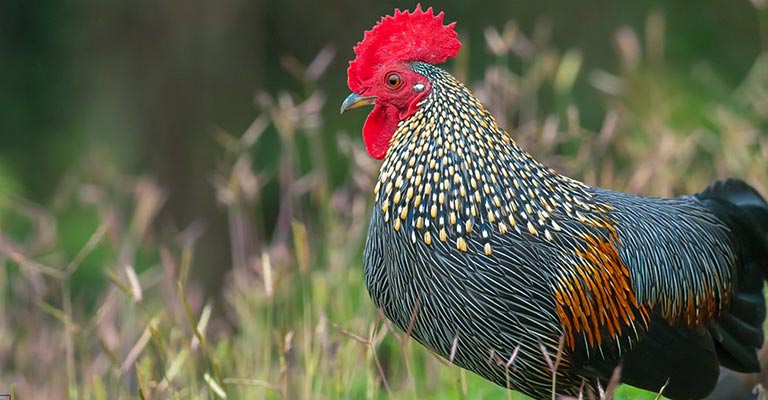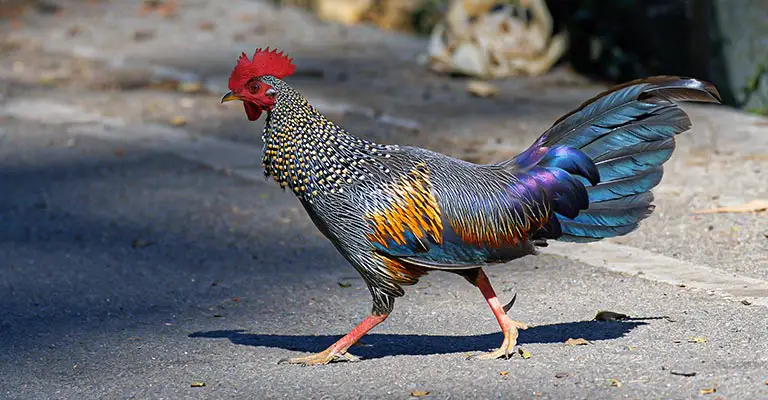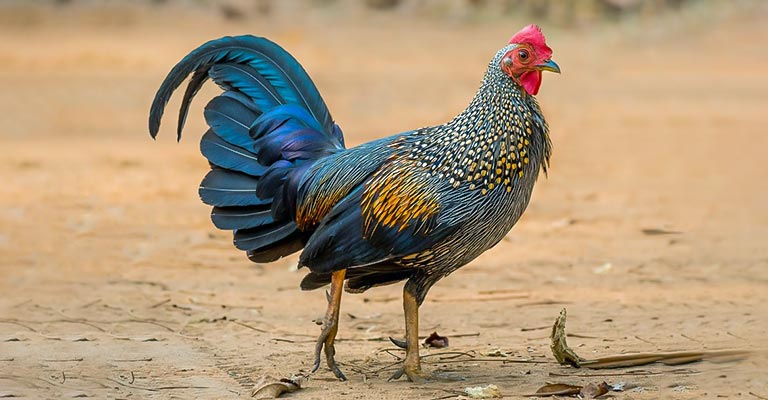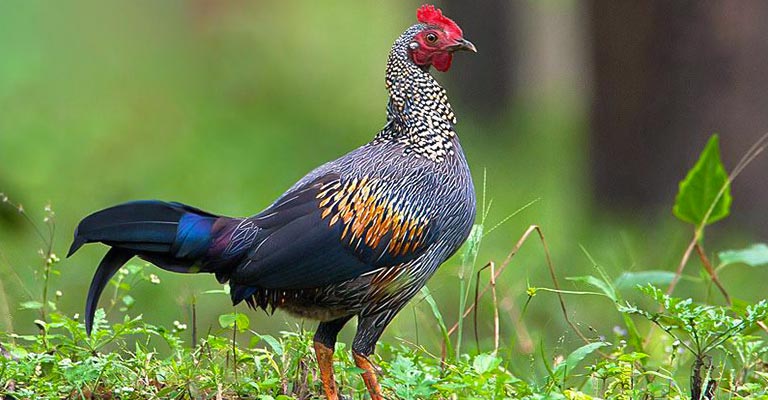Welcome to the captivating world of the Grey Junglefowl, a bird of remarkable beauty and significance native to India. While many may be familiar with its domestic relative, the chicken, the Grey Junglefowl stands apart with its stunning plumage and distinctive call.
This bird is a true spectacle of nature with an iridescent green crest and vivid orange-red feathers adorned with intricate black and white markings. Beyond its aesthetic appeal, the Grey Junglefowl plays a vital role in its ecosystem, contributing to the balance of its habitat.
Join me in exploring this fascinating species as we delve into its behavior, diet, habitat, and conservation status, uncovering the wonders of this enchanting bird.
Physical Characteristics of the Grey Junglefowl

The Grey Junglefowl, also known as Sonnerat’s Junglefowl, possesses various physical characteristics that distinguish it from other bird species.
Here’s an overview of its key features:
Size and Build
Grey Junglefowl are medium-sized birds with a compact build. They typically measure between 15 and 29.5 inches (38 and 75 cm) in length. Their bodies are well-adapted for ground-dwelling activities, featuring solid legs and sturdy frames.
Plumage
The plumage of Grey Junglefowl is predominantly greyish-brown, providing effective camouflage in their natural habitat. Males often exhibit more vibrant coloring during the breeding season, with a black cape adorned with golden or yellow spots.
Females have a duller appearance compared to males.
Feathers
Male Grey Junglefowl possess elongated neck feathers that end in small, hard, yellowish plates. These specialized feathers play a role in courtship displays and are also valued by anglers for making artificial flies.
Facial Features
Grey Junglefowl have distinctive facial features, including a sharp beak and eyes positioned laterally on the head, offering a wide field of view. Males typically have red wattles and combs, albeit less pronounced than those of red junglefowl males.
Legs and Feet
Their legs are strong and often adorned with bright red coloring. Males have spurs on their legs, which they use for defense and establishing dominance.
Eclipse Plumage
During or after the breeding season, males may molt their colorful neck feathers, transitioning to a more subdued appearance known as eclipse plumage.
The Habitat and Distribution of Grey Junglefowl

With their captivating plumage and lively demeanor, Grey Junglefowl have established their habitat across various landscapes in India, showcasing their adaptability and preference for natural surroundings.
Here’s a closer look at their habitat and distribution:
Habitat Preference
- Deciduous Forests: Grey Junglefowl thrive in deciduous forests, where they find ample cover and resources for foraging.
- Evergreen Forests: They also inhabit evergreen forests, enjoying the lush vegetation and diverse food sources in these environments.
- Scrublands: Besides forests, Grey Junglefowl can be found in scrublands, particularly those nestled in the foothills of the Himalayas.
Altitude Range
Grey Junglefowl are adaptable to a wide range of altitudes, from sea level to 3000 meters. This flexibility allows them to inhabit various terrains and climatic conditions.
Distribution
- India: Grey Junglefowl are distributed across most parts of India, excluding the extreme northern regions. They are found in both natural habitats and human-modified landscapes.
- Sri Lanka: They are also present in parts of Sri Lanka, contributing to the avian biodiversity of the island nation.
Absent Zones
Grey Junglefowl are notably absent from desert zones and heavily cultivated areas. These environments may lack the suitable habitat and resources necessary for their survival.
Population Density
The population density of Grey Junglefowl varies depending on habitat quality. They are typically found in higher numbers in well-preserved habitats such as protected reserves and national parks, where they can thrive undisturbed.
Conservation Status
While Grey Junglefowl populations remain relatively stable, they face habitat loss and fragmentation threats due to human activities. Conservation efforts, including habitat preservation and restoration initiatives, are essential for safeguarding these birds and their ecosystems.
Dietary Habits of Grey Junglefowl Birds

The dietary habits of Grey Junglefowl birds reflect their adaptability to their forest habitat and showcase a diverse palate.
Here’s a breakdown of their dietary preferences:
Insects
Grey Junglefowl have a penchant for protein-rich insects, with beetles and termites among their favorites. They exhibit precision in plucking insects from the forest floor, using their beaks skillfully.
Seeds and Berries
Like many bird species, Grey Junglefowl also enjoy seeds and berries as part of their diet. They happily munch on fallen fruits and fresh sprouts, demonstrating their foraging skills amidst the underbrush.
Reptiles
Grey Junglefowl are opportunistic feeders and occasionally indulge in small reptiles, such as lizards and amphibians when encountered during their foraging trips. This behavior showcases their adaptability and willingness to consume a varied diet.
Leaves and Petals
In addition to insects, seeds, and berries, Grey Junglefowl have been observed consuming certain types of leaves and petals. This behavior suggests dietary versatility, allowing them to use the resources available in their lush forest habitat.
Water
While Grey Junglefowl derive much of their hydration from their food intake, they also actively seek out water bodies for a refreshing drink.
Access to water sources is essential for their overall health and well-being, especially in the often humid environments they inhabit.
The Breeding Cycle and Behavior of Grey Junglefowl
The breeding cycle and behavior of Grey Junglefowl offer a captivating glimpse into their social dynamics and reproductive strategies.
Here’s a detailed exploration of their breeding cycle and behavior:
Peak Breeding Season
Grey Junglefowl typically breed during their peak season, from April to June. During this time, males engage in intricate courtship displays to attract females.
Courtship Behavior
Males showcase elaborate displays during courtship, including puffing up their feathers, spreading their wings, and performing dances accompanied by distinctive calls. These displays serve to impress and woo the females.
Nesting Habits
Once successfully courted, females proceed to build nests. They prefer hidden locations under thick vegetation or between rocks for protection against predators. This selection of nesting sites reflects their instinctual drive to ensure the safety of their offspring.
Egg Laying Period
Females typically lay around 4-7 eggs in one clutch annually. The incubation period lasts from 21 to 25 days before the eggs hatch, signaling the beginning of the next generation of Grey Junglefowl.
Social Dynamics
These breeding behaviors facilitate reproduction and provide insights into social hierarchies within flocks of Grey Junglefowl. Courtship displays and nesting behaviors may influence mate selection and group dynamics.
Behavior Outside Breeding Cycle
Outside the breeding season, Grey Junglefowl exhibit behaviors related to feeding and vocalization.
- Feeding Habits: They are primarily omnivorous, consuming seeds, insects, berries, and other food items in their habitat.
- Vocalization Patterns: Their vocal communication is diverse, with different calls serving as danger signals or markers of territory.
Conservation Status and Threats to Grey Junglefowl

The conservation status of Grey Junglefowl may be listed as “Least Concern” by the International Union for Conservation of Nature (IUCN), indicating a relatively stable population and widespread distribution.
However, various threats continue to pose risks to their long-term survival. Here’s a closer look at these threats and conservation efforts:
Habitat Loss
The primary threat to Grey Junglefowl stems from habitat loss. The rapid expansion of urban areas and agricultural activities, particularly in regions like India, where these birds are native, leads to the destruction and fragmentation of their natural habitats.
With suitable habitats, populations may be able to find resources and suitable breeding grounds.
Hunting and Poaching
Despite legal protections in place, hunting and poaching remain significant concerns. Enforcement of these laws can be challenging, leading to continued exploitation of Grey Junglefowl for various purposes, including food, traditional medicine, and the pet trade.
Such activities can exert pressure on local populations, especially when coupled with habitat loss.
Disease
While not as prominent as habitat loss and hunting, disease outbreaks can still threaten Grey Junglefowl. Avian diseases have the potential to spread rapidly within bird populations, causing significant mortality rates if not correctly managed.
Given the interconnected nature of ecosystems, disease outbreaks can be exacerbated by factors such as habitat degradation and human activities.
Despite these challenges, there is cause for optimism due to ongoing conservation efforts:
Conservation Initiatives
Various conservation organizations and governmental bodies are actively involved in efforts to protect Grey Junglefowl. These initiatives may include habitat restoration projects, captive breeding programs, and community education and engagement.
Regulatory Measures
Strict hunting, trade, and habitat protection regulations have been implemented in many regions to safeguard Grey junglefowl. Enhanced enforcement of these regulations is crucial for curbing illegal activities and ensuring compliance with conservation laws.
Awareness and Advocacy
Raising awareness about the conservation status and threats facing Grey Junglefowl is essential for garnering public support and fostering a sense of stewardship toward these birds.
Education campaigns, community outreach programs, and media coverage can all amplify conservation messages.
To Recap
The Grey Junglefowl is a testament to the beauty and resilience of nature’s creations. Our exploration has uncovered its striking plumage, distinctive calls, and vital role in maintaining ecological balance.
As stewards of the environment, we must preserve this remarkable species and its habitat.
By fostering greater awareness, implementing effective conservation measures, and promoting sustainable coexistence, we can safeguard the future of the Grey Junglefowl and countless other species.
Let us continue to marvel at the wonders of the natural world and strive to protect its diverse inhabitants for generations to come.
In the enchanting world of the Grey Junglefowl, there is both inspiration and responsibility, beckoning us to embrace our role as custodians of this precious planet.